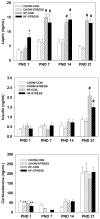Perinatal environment and its influences on metabolic programming of offspring
- PMID: 20394764
- PMCID: PMC2886179
- DOI: 10.1016/j.physbeh.2010.04.008
Perinatal environment and its influences on metabolic programming of offspring
Abstract
The intrauterine environment supports the development and health of offspring. Perturbations to this environment can have detrimental effects on the fetus that have persistent pathological consequences through adolescence and adulthood. The developmental origins of the health and disease concept, also known as the "Barker Hypothesis", has been put forth to describe the increased incidence of chronic disease such as cardiovascular disease and diabetes in humans and animals exposed to a less than ideal intrauterine environment. Maternal infection, poor or excess nutrition, and stressful events can negatively influence the development of different cell types, tissues and organ systems ultimately predisposing the organism to pathological conditions. Although there are a variety of conditions associated to exposure to altered intrauterine environments, the focus of this review will be on the consequences of stress and high fat diet during the pre- and perinatal periods and associated outcomes related to obesity and other metabolic conditions. We further discuss possible neuroendocrine and epigenetic mechanisms responsible for the metabolic programming of offspring. The paper represents an invited review by a symposium, award winner or keynote speaker at the Society for the Study of Ingestive Behavior [SSIB] Annual Meeting in Portland, July 2009.
2010 Elsevier Inc. All rights reserved.
Figures



Similar articles
-
Glucocorticoid excess and the developmental origins of disease: two decades of testing the hypothesis--2012 Curt Richter Award Winner.Psychoneuroendocrinology. 2013 Jan;38(1):1-11. doi: 10.1016/j.psyneuen.2012.08.012. Epub 2012 Sep 19. Psychoneuroendocrinology. 2013. PMID: 22998948 Review.
-
Early life origins of obesity: role of hypothalamic programming.J Pediatr Gastroenterol Nutr. 2009 Mar;48 Suppl 1:S31-8. doi: 10.1097/MPG.0b013e3181977375. J Pediatr Gastroenterol Nutr. 2009. PMID: 19214056 Review.
-
Prenatal stress or high-fat diet increases susceptibility to diet-induced obesity in rat offspring.Diabetes. 2009 May;58(5):1116-25. doi: 10.2337/db08-1129. Epub 2009 Feb 2. Diabetes. 2009. PMID: 19188431 Free PMC article.
-
Impact of maternal diabetes on epigenetic modifications leading to diseases in the offspring.Exp Diabetes Res. 2012;2012:538474. doi: 10.1155/2012/538474. Epub 2012 Nov 22. Exp Diabetes Res. 2012. PMID: 23227034 Free PMC article. Review.
-
Early life programming of obesity: the impact of the perinatal environment on the development of obesity and metabolic dysfunction in the offspring.Curr Diabetes Rev. 2012 Jan;8(1):55-68. doi: 10.2174/157339912798829214. Curr Diabetes Rev. 2012. PMID: 22352445 Review.
Cited by
-
Fetal programming of the neuroendocrine-immune system and metabolic disease.J Pregnancy. 2012;2012:792934. doi: 10.1155/2012/792934. Epub 2012 Aug 16. J Pregnancy. 2012. PMID: 22970372 Free PMC article. Review.
-
Epigenetic effects of prenatal stress on 11β-hydroxysteroid dehydrogenase-2 in the placenta and fetal brain.PLoS One. 2012;7(6):e39791. doi: 10.1371/journal.pone.0039791. Epub 2012 Jun 26. PLoS One. 2012. PMID: 22761903 Free PMC article.
-
Connecting the Dots in Childhood Obesity Disparities: A Review of Growth Patterns from Birth to Pre-Adolescence.Curr Epidemiol Rep. 2016 Mar 1;3(1):113-124. doi: 10.1007/s40471-016-0065-9. Epub 2016 Feb 15. Curr Epidemiol Rep. 2016. PMID: 27172171 Free PMC article.
-
Metabolomic profiling in blood from umbilical cords of low birth weight newborns.J Transl Med. 2012 Jul 9;10:142. doi: 10.1186/1479-5876-10-142. J Transl Med. 2012. PMID: 22776444 Free PMC article.
-
The Ghrelin-AgRP Neuron Nexus in Anorexia Nervosa: Implications for Metabolic and Behavioral Adaptations.Front Nutr. 2020 Jan 9;6:190. doi: 10.3389/fnut.2019.00190. eCollection 2019. Front Nutr. 2020. PMID: 31998738 Free PMC article. Review.
References
-
- Flegal KM, et al. Prevalence and trends in obesity among US adults, 1999–2000. Jama. 2002;288(14):1723–7. - PubMed
-
- Procopiou M, Philippe J. The metabolic syndrome and type 2 diabetes: epidemiological figures and country specificities. Cerebrovasc Dis. 2005;20(Suppl 1):2–8. - PubMed
-
- Ogden CL, Carroll MD, Flegal KM. Epidemiologic trends in overweight and obesity. Endocrinol Metab Clin North Am. 2003;32(4):741–60. vii. - PubMed
-
- Swinburn BA. The obesity epidemic in Australia: can public health interventions work? Asia Pac J Clin Nutr. 2003;12(Suppl):S7. - PubMed
-
- Tremblay MS, Katzmarzyk PT, Willms JD. Temporal trends in overweight and obesity in Canada, 1981–1996. Int J Obes Relat Metab Disord. 2002;26(4):538–43. - PubMed
Publication types
MeSH terms
Substances
Grants and funding
LinkOut - more resources
Full Text Sources

